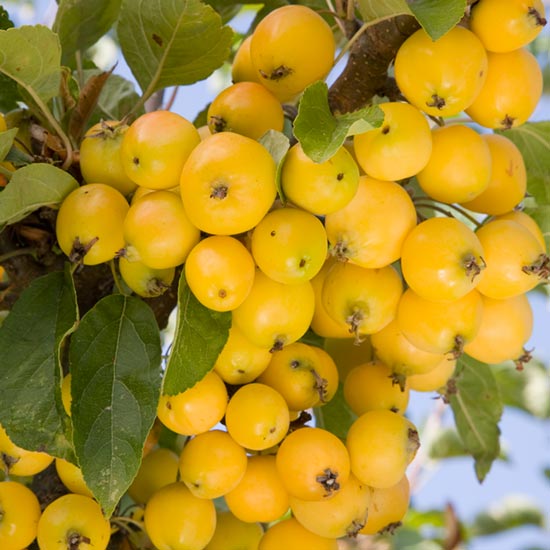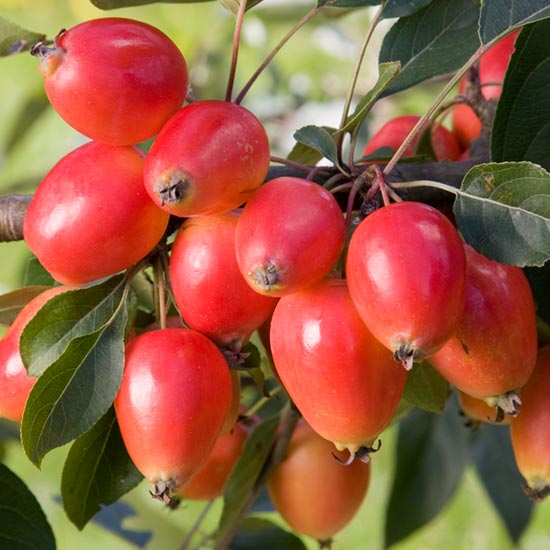Not only do ornamental crab apples (Malus) make perfect decorative garden trees but their fruits can be used to produce the most wonderful jellies despite their very astringent taste if eaten raw! Provided crab apples are grown on dwarfing rootstocks such as M26 they are not going to grow much taller than about 3.6m (12ft) high. Apart from the huge amount of crab apples each tree produces they look wonderful in spring with a vast amount of often scented flowers which can range from pure white to deep pink. Some varieties even have a purple foliage but they all produce wonderful red, pink, orange or yellow coloured fruits that can be round or oval and look just like miniature apples. And a real bonus is that if you grow apples these crab apples are perfect pollinators for them as they have a long flowering period; indeed, crab apples are often planted in commercial orchards to maximise pollination opportunities
Fortunately crab apples are very hardy and easy to grow and will tolerate almost any garden soil. They prefer to be in the sun although partial shade will suffice. Unfortunately, some of the best crab apples (such as the well-known John Downie) are susceptible to apple scab in the wetter areas of the country but there are some fairly resistant varieties available. If you are able to do it, clearing up fallen foliage and fruits in the winter months may help keep any scab until control.
With the production of excellent crab apple jelly in mind I highly recommend the following varieties:
Butterball produces large clusters of wonderfully yellow fruits which often gain a reddish flush in autumn. A real bonus is that in the spring the tree is smothered in soft pinkish-white blossom. This is an excellent alternative to the well-known crab apple Golden Hornet as it is heavier cropping and more reliable.
Evereste is a very popular crab apple that is often planted for decorative purposes as it has unusually large soft pink-white flowers which open from deep red buds. The flowers are followed by heavy crops of small red flushed orange-yellow fruits that will hang on the tree until well into December. Another benefit of this cultivar is that it has a compact conical growth habit which makes it an ideal choice for small gardens. The tree is resistant to apple scab.
Golden Hornet is a popular choice for gardens because its slightly oval fruits are golden-yellow and may well hang on the tree right through the winter months. Unfortunately the tree can suffer badly from apple scab so is best avoided in wetter parts of the country. Other cultivars such as Butterball may be considered a better alternative in these situations. The large white flowers are profuse and have a pretty pink blush. Golden Hornet is an excellent pollinator and often used in commercial orchards.
Gorgeous produces a mass of scented white blossom followed by yellow/red fruits that resemble the most perfect miniature apples that may hang well on the tree until the end of the year. The dark green foliage is tinted orange-yellow in autumn. The tree has a high degree of resistance to apple scab.
Harry Baker is named after the former Fruit Superintendent at the RHS Wisley Gardens, and has big pink flowers and large, ruby-red, pink-fleshed fruit that is widely considered to be the very best for making crab-apple jelly. It is often grown for decorative purposes alone and a real bonus is that it has good resistance to apple scab.
Jelly King produces profuse and long-lasting pure white blossom leading to heavy crops of relatively large orange-pink fruits that hang on the tree well into the winter months. This aptly named variety was largely bred for culinary use and is a superb garden tree as it stays very compact.
John Downie is probably the most popular crab apple grown in gardens although it is highly susceptible to apple scab. However, it retains its popularity as it produces masses of pink budded white blossom in the spring followed by bright red and orange fruits in the autumn that are almost sweet enough to be eaten raw when ripe and which will hang on the tree well into winter.
Laura is a newly introduced dwarf crab apple bred by the late apple breeder Hugh Ermen. It produces stunning bi-coloured pink and white blossom and dark purple-green foliage in the spring. The dark fruits will hang on the tree until late winter and make a superb deep red jelly. This is an ideal crab apple for the smallest of gardens or for growing in a container.
Montreal Beauty is a fairly small growing crab apple which produces large white flowers followed by large eye catching orange-red fruits that have similar colouring to John Downie but are larger and rounder with far better apple scab resistance.
Neville Copeman is a heavy fruiting and very decorative crab apple which produces light purple blossom in the spring, reddish new foliage that matures to green and large apple shaped red fruits which may well hang on the tree through the winter months.
Pink Glow produces large white single flowers which are followed by early fruiting fairly large pink/purple fruits which will hang on the tree until late autumn. Like Montreal Beauty this is an apple scab resistant alternative to John Downie. The name of this cultivar really sums up the look of the fruits which are highly decorative.
Red Sentinel is a well-known decorative variety with an upright habit. It produces large amounts of single white flowers followed by clusters of cherry like yellow fruits blushed with red turning to a glossy deep cherry red by Christmas. These fruits hang on the tree well into late winter and are very popular with winter feeding birds. The tree has good resistance to apple scab.
Gerry Edwards
8th March 2017
Gerry is an experienced amateur fruit grower who is Chairman of the RHS Fruit Group, a member of the Royal Horticultural Society’s Fruit, Vegetable and Herb Committee and also their Fruit Trials Panel. Gerry judges fruit nationally for the Royal Horticultural Society and is also a qualified National Vegetable Society judge.


